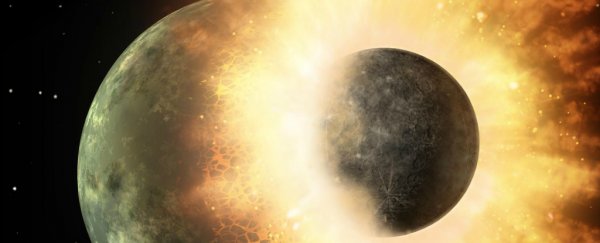Currently, the leading hypothesis of the creation of the Moon is that it formed from a giant impact between a very early Earth and another Mars-sized planet.
Yet new research from the Weizmann Institute of Science in Israel has put forward a hypothesis that the Moon may have actually formed from a series of large impacts, rather than just one.
The study, published in the journal Nature Geoscience, explains why the Moon appears to be made mostly from Earth-like materials, rather than a mixture of our elements and those of another mystery planet.
Lead author Dr Raluca Rufu and her colleagues conducted some mathematical simulations of what it would look like if large planetary bodies collided with our Earth way back when it was newly formed around 4.5 billion years ago.
In these tests, the impacts produced disks that shot off from Earth and the other body, but were mostly made up from Earth materials.
According to their results, it would take about 20 of these collisions to assemble the moon. Rufu told Business Insider that it is much more likely that the Moon formed from many smaller collisions, because it is a more organic process.
"The multiple impact scenario is a more 'natural' way of explaining the formation of the Moon," Rufu said.
"In the early stages of the Solar System, impacts were very abundant, therefore it is more natural that several common impactors formed the Moon, rather than one special one."
Also, Rufu said that the current theory doesn't really explain why the Moon is so similar to rocks on Earth.
"If multiple of bodies contribute to the final Moon, their chemical signatures can even out, therefore the traces of the various impacts will be masked," she said.
"Also, higher velocity impactors can excavate more Earth material, hence the moonlets will resemble Earth's composition."
The team suggest in their paper that moon-forming impacts between the early Earth - known as the proto-Earth - and other large bodies floating around were very common during the early days of the Solar System.
Therefore, this series of events can probably be applied to other planets and moons.
"We see evidence of past impacts on all the terrestrial planets," said Rufu.
"This paper shows that moonlets can be commonly formed, therefore the lack of moons around Venus is an interesting follow up question of how planets can sometimes lose their moons."
Proof of this new theory may lie in the heart of the Moon itself. If multiple impacts are the key, this implies that the Moon formed over many millions of years, rather than in a single massive crash.
This would mean that Earth and Moon's interiors could be less mixed up, and may have preserved a record of the events.
This article was originally published by Business Insider.
